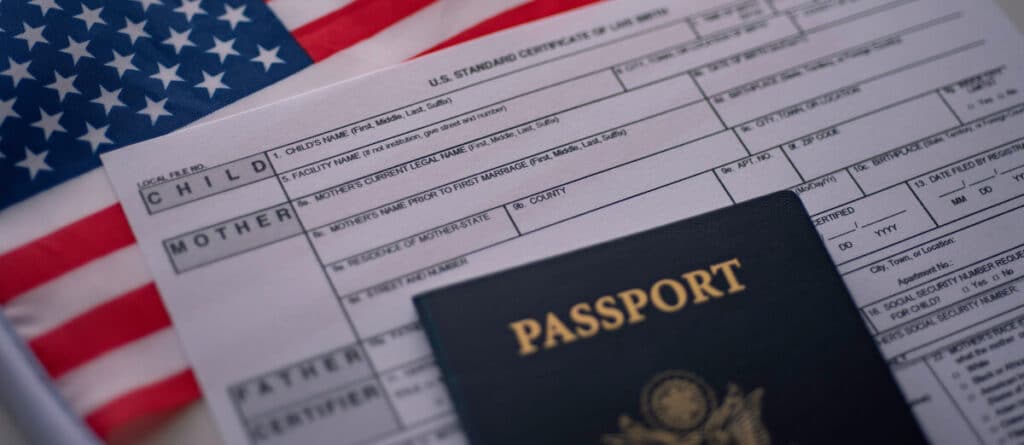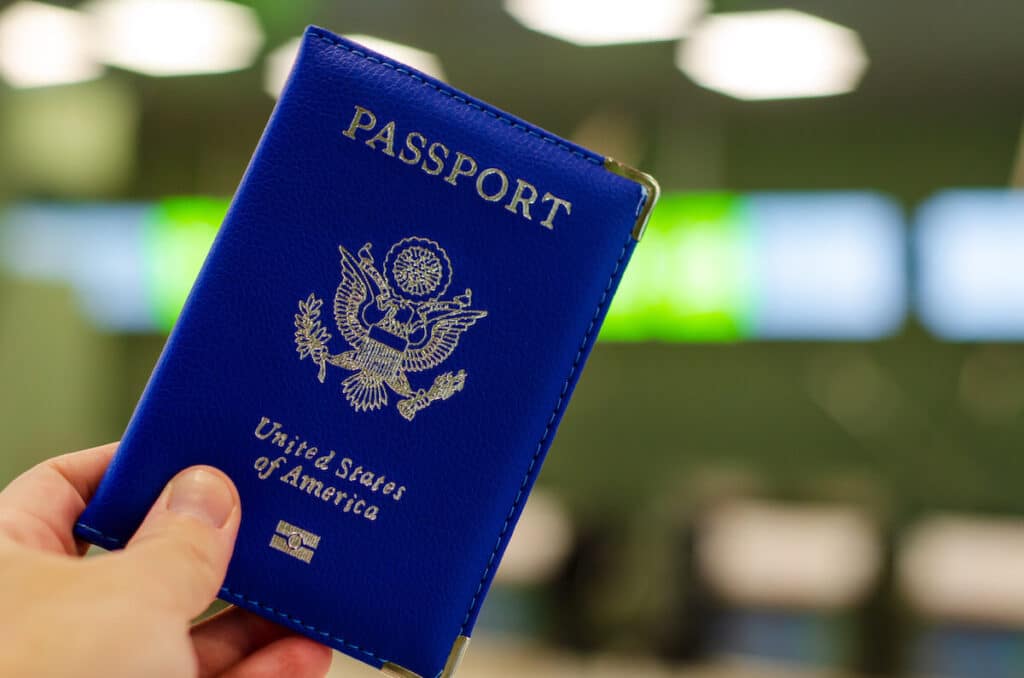If you’re a U.S. immigrant, you may know that you need a passport to visit loved ones back home or travel internationally, but you may not be sure how to apply for a passport due to your immigration status.
At Remitly, we created this guide for first-time applicants to share the correct procedure for applying for a new passport based on their immigration status.
How to apply for a U.S. passport
1. Gather the required documents
The first step in applying for a U.S. passport is to gather the following documents, which include:
Proof of U.S. citizenship
As an immigrant, your evidence of U.S. citizenship documents will likely be your Certificate of Citizenship, Certificate of Naturalization, or Consular Report of Birth Abroad.
If you meet the requirements for being classified as a non-citizen U.S. national, as discussed later in this article, you would instead show proof that you or your parents were born in American Samoa or the Swain Islands. Typically, a certified birth certificate is acceptable proof.
Photo identification
When you apply for a U.S. adult passport, you must verify that you are who you say you are by presenting a valid photo ID. Acceptable forms of ID include:
- Driver’s license
- State-issued ID
- Government employee ID
- Military ID
- Foreign passport
- Trusted Traveler ID
If you don’t have any of these forms of identification, you can submit two secondary IDs instead. Visit the U.S. State Department website for a complete list of acceptable IDs for the U.S. passport application process.
Your ID must be current to be acceptable. In other words, an expired foreign passport or driver’s license won’t be adequate.
Photocopies
When you apply for a U.S. passport with the passport agency, you must bring your birth certificate, original proof of citizenship, photo ID, and photocopies of each.
Passport photos
The final thing you’ll need to obtain a U.S. passport is two passport photos. They must be:
- 2-inches by 2-inches in size
- Taken in the last six months
- In color and unfiltered
- Photographed against a white background
Get tips on how to take the perfect U.S. passport photo on the State Department website.
2. Complete the passport application
Once you have the required supporting documents all gathered, you’re ready to complete the U.S. passport application form, called Form DS-11. There are three different ways to do so.
Fill out and print
The first option is to use the U.S. State Department’s form filler tool, which you can access here. This tool allows you to fill in all the boxes of the application form one by one. When you’re finished, you can print the completed form.
Print and fill out by hand
The second option is to download the form to your computer, print it out, and then complete it by hand. You can access a downloadable copy here.
Obtain a paper copy
If you don’t have a printer or prefer not to download the form, you can pick one up from a passport acceptance facility and then fill it out by hand. We’ll tell you more about passport acceptance facilities in the next section.
Tips for completing the U.S. passport application form
To ensure a smooth process, follow these tips when completing your first U.S. passport application form.
Use the right color ink
For your passport application to be valid, only use black ink when printing or filling out the form by hand.
Print extra copies
The State Department may not accept an application with scribbled-out information or corrections made with liquid paper. If you intend to fill out the form by hand, print more than one copy, or request an extra from the passport facility so you can start over if you need to correct something.
Read the instructions carefully
A detailed list of instructions comes with the full application package. Place the instructions beside the form and refer to them as you move from box to box to ensure you don’t make errors.
Don’t sign ahead of time
You can fill out the entire application form prior to proceeding to the next step. However, you must leave the application unsigned, as the attendant at the passport acceptance facility must witness your signature.
3. Attend the passport appointment
Many immigrants search for information on how to apply for a passport online in the U.S., but the truth is that you can’t.
While you can complete and download the form online, you’ll need to apply at a passport acceptance facility during a passport appointment. Read on how to apply for a U.S. passport to learn more about this step in the process.
Where do you go for your passport appointment?
There are more than 4,500 passport acceptance facilities in the U.S., including public libraries, post offices, and local government offices.
Use this tool to find the location closest to you.
Do I need to schedule a passport appointment ahead of time?
Each passport acceptance facility establishes its own rules regarding appointments. Some require you to call, email, or book online to obtain an appointment date, while others accept walk-ins on a first-come, first-served basis. Some also provide passport photo services for a small fee.
Once you find the most convenient facility in your area, contact them to find out their hours of operation and whether you need an appointment.
How long does the passport appointment take?
The passport services appointment usually takes around 15 minutes. Some facilities will take passport photos onsite. If your facility offers this and you plan to use this service, the appointment may take longer.
What happens at the passport appointment?
During your passport appointment, the attendee will ask questions to verify who you are and examine the documentation you brought.
Then, they will review your passport photos and review your application to ensure everything is filled out correctly.
Finally, they will ask you to sign the application form in front of them.
What are the fees for getting a U.S. passport as an immigrant?
At your passport appointment, you’ll need to pay an application passport fee. The application fee depends on whether you want a passport book, a passport card, or both. Your age will also affect the cost. It is important to check the latest information, as the cost of a passport in 2025 may differ from current rates. Additionally, expedited services and renewals may incur additional fees. Being aware of these costs will help you prepare financially for your passport application.
To determine your payment amount, use the fee calculator on the State Department website. This also includes renewal fees.

Passport processing and waiting period
Although the passport acceptance facility collects your application, photos, and copies of your documentation, the center doesn’t process your application or decide whether to approve your request.
Instead, the State Department handles all applications submitted throughout the entire U.S.
Processing time depends on demand and staffing. Generally, you should expect to wait around 6 to 12 weeks. When you submit your application, visit the State Department website for more specific processing times.
If you need your passport quickly, you can pay additional fees for expedited service. You can pay with your credit or debit cards, a check, or a money order.
Throughout the processing period, you can check the application status here.
Receive your passport
When your passport is ready, the State Department usually sends it to your mailing address via U.S. mail or priority mail express.
Some passport acceptance facilities allow you to pick up your passport in person. If you’re interested in the service, ask the attendant about it during your appointment.
Once you receive your passport, put it in a safe place, such as a locked safe, a locking fireproof document box, or a safety deposit box at a bank.
Determine if you’re eligible for a U.S. passport
In the U.S., the Department of State issues passports, following guidelines established by federal laws.
An important step in obtaining a passport in the U.S. as an immigrant is to determine whether you qualify for a U.S. passport under these guidelines or will need to obtain one from your home country. If you determine that you qualify for a U.S. passport, the next step involves gathering the necessary documentation and filling out the application form. For parents or guardians seeking to understand how to apply for a child’s passport, it’s essential to include the child’s birth certificate and proof of parental consent. Additionally, check for any specific requirements that might vary based on the child’s age or nationality.
To be eligible for a U.S. passport, you must meet certain requirements, including all of the following.
Citizenship
In the U.S., you must typically be a citizen to obtain a passport. As an immigrant, this means you will have to be or become a naturalized citizen, meaning that you received citizenship status as an immigrant. We’ll discuss more about what that means in a minute.
There is one exception to this rule made for non-citizen U.S. nationals. This term refers to someone who was born or whose parents were born in American Samoa or the Swain Islands.
If one of these two situations applies to you and you’re a U.S. immigrant, you will likely be able to apply for a U.S. passport—provided you meet all other eligibility criteria.
Child support
If you received a court order to pay child support in the U.S., you must keep up with your required payments to qualify for a U.S. passport. Anyone who owes more than $2,500 in unpaid child support will typically have their U.S. passport application rejected.
Tax debts
Sometimes, owing money to the IRS for unpaid taxes can prevent a person from obtaining a U.S. passport.
If a person owes the IRS more than $59,000, the agency will issue a letter called Notice CP508C that notifies them of the debt.
Until the debt is paid in full or the person enters an installment plan or a settlement agreement with the IRS, the State Department will usually not grant them a U.S. passport.
However, there are some exceptions to the rule. A passport application request may still be approved if the person is in bankruptcy, lives in a place deemed a disaster area by the U.S. or has had their tax account put in an uncollectable status because of financial hardships.
Delinquent loans
In some cases, the U.S. will issue crisis evacuation loans to people living abroad who need to return to the United States. If you receive one of these loans and fail to make payments, you will typically be unable to receive a U.S. passport until you bring your account up to date.
The loan delinquency rule doesn’t usually apply to other government-backed loans, such as small business loans or student loans.
Criminal activity
A criminal conviction does not necessarily prevent a person from obtaining a U.S. passport. However, the State Department usually does not issue passports to people awaiting trial, on probation, or parole.
Individuals who have served their full sentences and are no longer under criminal supervision can typically apply for and receive a U.S. passport unless they have been placed on a Terror Watch List.
What is a U.S. naturalized citizen?
Now, let’s get back to the question of naturalization. Simply put, a naturalized citizen is someone who wasn’t born a U.S. citizen and instead became one after immigrating to the U.S.
If you already went through the naturalization process and didn’t have unpaid child support, tax or loan delinquency, or a criminal history that would prohibit you from applying, you’re likely eligible to apply for a U.S. passport now.
People whose immigration status is something other than naturalized citizens will need to become naturalized to obtain a U.S. passport. Read on to learn more about naturalization.
Read more: What is Naturalization in the U.S. and Who Is Eligible?
Eligibility pathways
There are four main pathways to becoming a naturalized citizen:
- Green card status: Individuals who obtain permanent residence or green card status and reside in the U.S. for at least five years can take the next steps to becoming a citizen.
- Marriage: People married to U.S. citizens are generally eligible for naturalization.
- Military service: Immigrants who serve in one of the branches of the U.S. military can usually become naturalized.
- Parents: If your parents are U.S. citizens, you may qualify for naturalization.
Requirements
If one of the eligibility pathways outlined above applies to you, you may qualify for naturalization, provided you meet the following requirements:
- You’re at least 18 years old.
- You can read, write, and speak basic English and can pass a test to demonstrate this.
- You are of good moral character, meaning you’ve never been convicted of a serious crime.
- You’re knowledgeable about U.S. civics and customs, as demonstrated by passing the citizenship test.
Learn more about naturalization requirements on the U.S. Citizenship and Naturalization Services website.
Are you eligible for naturalization?
U.S. Citizenship and Naturalization Services (USCIS) offers an online tool to help you quickly determine eligibility for naturalization.
If you are, you’ll need to proceed with the process before you apply for a U.S. passport. If you aren’t, jump to the bottom of this post to learn how to apply for a new passport from your country of citizenship.
If you decide to become a naturalized citizen, keep in mind that you may need to renounce your citizenship in your home country.
Some countries allow for dual citizenship, so you can retain your citizenship there and become naturalized in the U.S. Others don’t, so it’s a good idea to check the dual citizenship laws in your country of origin before proceeding.
How to apply for a new passport if you’re not a naturalized citizen
If you’re not a naturalized U.S. citizen and need a passport, you’ll need to apply through your home country.
You can contact an embassy or consulate in your home country to learn eligibility requirements and how the application process works. This directory provides information for all foreign embassies and consulates in the U.S. to help you get started.
Before you travel
Whether you obtained a U.S. passport or a new passport from your country of origin, follow these tips before traveling abroad.
Check for travel warnings
Before traveling abroad, check the U.S. Department of State webpage for travel advisories. These bulletins can tell you what areas to avoid to stay safe while traveling internationally.
Register with the embassy or consulate
If you plan to travel abroad, let the embassy or consulate office know to ensure you can access services.
If you’re a U.S. citizen, you can find a complete listing of embassies and consulates here, including the U.S. Embassy.
Make copies of your passport
Before you leave for your trip, make copies of your passport. Leave one with a trusted person in the U.S. whom you can contact if you have an emergency. Place another inside your suitcase and transfer it to a safe place, such as a hotel vault, once you arrive.
Get ready to apply for your passport as an immigrant
Now that you know how to apply for a passport as an immigrant, you’re ready to take the first steps. Gather the required documentation and prepare for your passport appointment so you can travel abroad.
Whether you’re at home or traveling, Remitly makes it simple to send money to loved ones.

